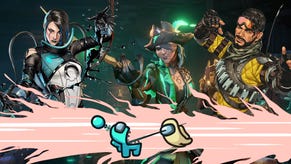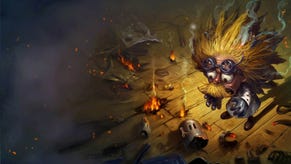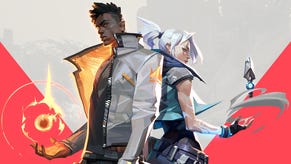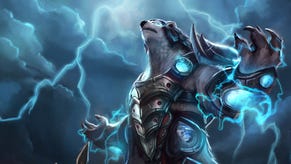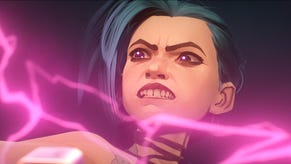League Of Legends: Riot Kades Talks Mechs Vs Minions
The journey from concept to finished boardgame
Earlier this week Riot announced its first foray into boardgames with Mechs vs Minions - a co-op tabletop experience set in the League of Legends [official site] universe. If you're a boardgamer you'll get the basic concept from "Robo Rally meets Descent" with a Legacy-esque campaign component. If you're not, probably the easiest way to put this is that you're working together to program little characters in mech suits so they can be victorious in their missions, although taking damage can make them go haywire (as can, for example, misreading cards and forgetting your mech will turn 90 degrees and thus you end up accidentally on the other side of the board throwing a ripsaw into thin air. FOR EXAMPLE.) It's also heavier than most newborns, coming in at 12.8 lb on my bathroom scales.
I played snippets of the game during development (I guess kind of like videogame previews) so I was pleased to talk with Mechs Vs Minions lead Chris 'Kades' Cantrell to see how the idea had developed over time, how Riot had made the ridiculously huge game remotely affordable, and how RPS alumnus Quinns had managed to make more work for everyone (in a good way):
Pip: Hi Chris, can you introduce yourself and talk a little about your role on the project?
CC: I'm a producer at Riot Games. I'm the product owner - basically the wringable neck - on Mechs vs Minions. I guess producer means different things at different companies. Here it means I get to wrangle far more talented people. If there's anything about the game you like I can tell you who did it but if there's anything you don't like about the game that was probably my fault.
Pip: When people ask about the game what's your elevator pitch?
CC: For boardgamers it's Robo Rally meets Descent. It's a pretty concise elevator pitch - we'd only have to go up a floor! For League players it's a bit difficult because you really need to provide the context of how awesome board games have become in the past five or ten years - the renaissance, or golden age. Without understanding that fully, to think of a board game you tend to think of something like Monopoly or Risk or games that - Monopoly is like 113 years old and board game design has evolved a lot in the last 113 years. This is our stab at looking at modern board games.
Pip: The couple of times I've played Mechs vs Minions it's been a version pretty close to the one you're releasing but can you tell me about the evolution before that point?
CC: At the very beginning we were bringing a designer on at Riot who we really like a lot called Stone Librande. That was almost three years ago and as we were looking to enter him into the company he was telling us about... He's a designer's designer. He loves designing for the joy of making these experiences and, true to that nature, even though he's a videogame designer he's designed a lot of board games and hasn't published any of them. It's really just stuff he was doing for his family. When we brought him on we got to play a prototype of a version of his game and we really liked it. It didn't have anything to do with League or anything like that but a lot of that core element is still in the game - that programming aspect where you can stack cards on top of each other - and we hadn't seen that before.
[Before moving on with the interview I'm just going to explain about how MvM works in terms of the basic structure so the programming reference makes sense. You each have a command line card in front of you and on that command line you can slot in cards which then determine how your character's mech moves and attacks when it takes its turn. You can stack cards of the same element to access upgraded options. Sometimes you'll also take damage which affects the command line. There's more to it but that's a decent overview.]
So we got that design from him and I spent about a year and a half sequestered in some closet trying to figure out where the game would land. I thought I had it done. I was actually pretty confident I was done and we were going to move into manufacturing. But because I'd never done this before I thought, well I'll reach out to Tom [Vasel from The Dice Tower] and Quintin [Smith, formerly of RPS, now of Shut Up & Sit Down and Cool Ghosts]. Tom came out first and it's harder to attribute specific things to him because he just had a lot of comments that helped us streamline the experience. He was very helpful. Then at the end he was like, 'You know what guys, I think you have a good game, I'd ship it out. I don't think you have anything to be worried about.'
We're doing high fives and really stoked along those lines. Then we already had Quintin on the books to come out and I was just giddy to meet him because I'm a fanboy, right? So we had him come out and he played it once and he was like 'Well, I'm here for the next two days so I'll help out however you need me but honestly I don't think I'd play this again. I had fun but I don't know why I'd play it again when I have so many other games'
You could look around the room and obviously it wasn't the answer we were hoping for but as we kept talking about it we realised he was right and we shifted away from this large board, based on his advice, to modular boards. He suggested a campaign and then we kind of designed ten games around it instead of one. It actually amounted to a lot more work but ultimately the game is so much better so I couldn't be more tickled with where it landed. But we had to bring in another designer, Rick Ernst, to help us construct those missions and then we brought in a handful of other people to make sure play balance was correct. You got to see a part of that evolution a year ago at Gen Con.
Pip: I played after the switch to modular boards but I think you were still feeling your way on the campaign structure and things like that. On that subject, how do you feel in terms of replayability given you've gone with a campaign structure - is that a concern?
CC: Oh, it's definitely a concern. I remember when I first tried to convince my boss's boss that we wanted to switch to this modular board thing because, like me, he thought we were close to done. It was like... 'Wait, you want to do ten?' And I was like, 'Yeah, it's a nice round number!' He was like, 'But we already have one. Why don't you launch it with two and maybe we'll have a third one online?'
Ultimately I guess I got enough rope to hang myself and he was like, 'Alright, let's do this'. But of course it's a concern. Honestly though, when I have that concern it's stemming from the idea of me playing chess or checkers as a kid and I had the ability in my head to replay it an infinite amount of times. But with Pandemic Legacy or Risk Legacy they give you lots of options to keep exploring the game. When I first look at the purchase I'm a little wary - am I really getting enough value of of this? But after I've done all the playthroughs of Risk or Pandemic Legacy the answer for me is a resounding yes. This is a lot of game and I feel like I got a lot of time and money's worth out of it.
Even some of my favourite games, when the new hotness comes out - like Cry Havoc - it's rare that I have the time to pick one game and play it 30 or 40 times. There's so much great stuff coming out in the industry and I'm always looking for new ways to have fun with my friends, so yes it's a concern. Any time you have a limited number of missions that should be a concern. But after years of playtesting this game, playing maybe a couple of thousand times, I still have fun playing it, I still look forward to playing the next game so I do think there's replayablity but I'm a biased source so take that with a grain of salt.
Pip: From what you were saying earlier, the game started out with this League-agnostic seed, then you were bringing people on board and integrating it into the LoL-iverse - can you tell me more about that process?
CC: So we knew it was a programming game. At the time we didn't even know it was going to be co-operative but we knew it was going to be a programming game and so honestly the first thing I jumped to was our robotic characters. We have characters like Blitzcrank [a steam-powered golem whose AI develops into independence] and Orianna [a clockwork killing machine a father built to replace his dead daughter] in our game. Robot programming game - problem solved!
As we played through the experience one of the things that happened is when you get damaged [your character can] go where you don't want to go. You're running into lava by accident and your machine starts going haywire. That didn't really feel true to Blitzcrank and Orianna, even if they're injured in League they're still going where you want them to go - you don't lose control over them. That was really frustrating.
But with Rumble, he made a mech and there are even times in the game if you're familiar with this kit that if you use it too much his mech starts going haywire and you can't control it. It overheats and stuff like that. It's this really janky, junkyard robotic mech. We were like, what if we centre it round Rumble? The next thing that came up was, if we're doing Rumble why would anyone not want to play Rumble even if we throw in all these other Yordles? So the thought became, what if Rumble opens up a school for mechs and brings on some other Yordles that we're fans of. Not that we're not fans of Rumble, but some other Yordles! Then he's teaching them and all of a sudden we had a narrative and a tone for the game. When these Yordles, who are just learning to pilot, when their mechs start breaking down and going off in these zany directions, instead of it feeling frustrating it became silly and whimsical and absurd, which was much more in the spirit of the game we were trying to create.
Pip: When I played a version of the game back at GenCon it was printed on foamcore and had pieces borrowed from other games as stand-in counters and things. Seeing the finished version from various unboxings it's this massive thing with pre-painted miniatures and these little plastic trays with lids to keep the bits safe and all manner of things - lots of extra touches and attention to detail - so my main question is how is it even remotely affordable?
CC: *laughs* We kept the cost down by selling direct to players. I don't know if we'll ever make another board game. I don't anticipate this being a part of our portfolio. I guess that could change but our goal was primarily to get this out to as many people as we could - as many League players to maybe be an introduction into modern board games and then as many board game players as we could. The thing was, if we really doubled down on quality in the direction we wanted to go and that we ended up going the game would have to cost probably $200-$250 if you look at the standard 5-7x markup rate that every board game does. We knew maybe there are some hardcore board game guys out there - there's probably a small market for that in board games - but League players aren't going to jump ship for a $250 board game. It didn't make any sense. So I made the tough call - it's something that for months kept me up nights because I love my friendly local board game shop and I spent formative years in comic book stores and board game stores and whatnot. The idea of taking them out of the process was not something I came to lightly, but ultimately I guess I just decided that I wanted to make this game for players not for board game stores and if I could find a way to get the cost cheaper then I kind of owed it to players to do that.
That was the approach with Mechs vs Minions. If, in a world where we ever made another game, that doesn't have to be an evergreen approach, it's just for a game with this many miniatures and this quality of components I thought that was the more player focused approach. I hope I'm right. I hope the industry doesn't hate me for it!
Pip: The talk about the cost of the game helped highlight differences between the general board games community and the general League of Legends community. Obviously there's some crossover so this is just generalities but board gamers often had the response "How is it that cheap?" and League players were saying "How is it this expensive?" How did you keep differences in those communities in mind when talking about MvM?
CC: To be honest it didn't just happen on Reddit, it happened internally here for months. There was just no - at least from my perspective - this hadn't really been done before, at least not at the scale we were trying to act. It terrified us with margins as thin as we've kept them and the game would be profitable at $75 but if we sold ten units it's definitely not profitable. It scared us that we weren't sure if the League community who are used to a free-to-play game would be interested in this $75 game. I think that's a lot of money regardless of the quality of what you're getting. $75 is always going to be a lot of money.
So we had people who didn't play board games but really understood our players and they were terrified. They thought we were being foolhardy. We had lots of conversations, like maybe we should sell the game at a loss for $30 or maybe we should charge $200. Thankfully - or at least thankfully for the moment - it's $75. It's the inbetween area - the upper end for League of Legends players but still would showcase the value that I hope it represents to the board game community. The only other option was to reduce the cost while drastically reducing the quality of the game, not having miniatures and using cardboard pieces. But that wasn't a game we were really excited about. We'll see. Ultimately it matters if players look at it and say, "This is ridiculous, we didn't need all this. You should make me another version where I don't have to fork over all this money for such a slapdash product," then we'll pivot and try to make that version if that's what players want.
Pip: When I played most recently - so, December 2015 - the ability that felt most like something from the game was the chain lightning. I loved how when you upgraded that a few times it bounced all over the place, taking out minions. Do you have any personal favourites, or abilities which you thing worked really well in the transition to board game?
CC: As a designer you're always looking for really elegant solutions. There are times when you have to go outside that but you do it painfully, so it's exciting to me that you mention chain lightning because I think chain lightning is a very fun skill and what I like about it is I think it has a very high skill cap. On the flip side it's kind of clunky. If I tell you what a speed does - move one or two spaces - you're like, "Okay". If I tell you what chain lightning does you sit and study it for a few seconds and you're like, "Wait, what?" That pain is one of the things we spent so much time polishing the UX around it and making sure it made sense and that it flowed correctly.
I think Omnistomp is rarely a bad choice. It's different because when we did internal playtests we would ask people what was their favourite game card. In the beginning we got a lot of the same answers - memory core, and different iterations of cards that have since been changed. We knew we were landing in the right spot when we would ask that question and consistently hear back that it depends on the mission. There are missions where you're being chased by lava so you want speed to zip through. There are missions when [minions are] coming from far away at the beginning so ripsaw helps thin the herd before they get there. There are missions where they spawn all around you and a chain lightning or fuel tank are a lot more valuable than they are in the long distance situations or when there are a lot of walls ripsaw ends up not helping because they get blocked by walls or other mechs.
Pip: The game ended up being for 2-4 players so when there are two players is that like playing on hard mode or have you balanced the challenge?
CC: This was a Rick Ernst special. Our lead designer, Rick Ernst, he was right - I didn't know how - a lot of time we were doing four player so I was like, we need to figure out two player and three player. He said "What if we just give them more cards?" I thought that was absurd. When he told me I was like... alright, I'm going to trust you, let's try it but I think we're wasting a playtest. Then we did it and the response was really strong. So let's try it again because that's not enough data.
They played the entire campaign with two people and three people. People really enjoyed it. In retrospect the thing Rick had spotted which I'd failed to do was the real power growth in the game comes when you draw your cards. So when you're drawing those cards and you're either putting them on your command line or whatnot, in a two-player game - in every version of the game you're always drawing four cards so with four people everyone gets one, with three people the first player gets two each round, and in two-player both players get two. That ended up balancing the game far more elegantly than I would have expected was possible.
There are situations where you need to do three or four different things and you only have two people so it can be hard but you also scale up in power much quicker. There are also fewer opportunities for your team to take damage. There are eight spots on the board where your team can take damage [with only two players] as opposed to 16 with four players. They're also getting stronger quicker and that offsets what they're being asked to do.
I will say if you play the game with two people and you find it really hard, it is a very hard game. If you play the game with four people and find it hard, it's still a very hard game. I don't anticipate that people will beat every mission out of the gate. I find that pretty unlikely, which is fine. I think co-operative games, in order for it to feel not trite, you really need to feel a sense of pressure, you need to feel worried and there's something your team has to overcome. If you don't overcome something difficult you don't feel rewarded at the end of it. So you're not going to win every game and if you only play the two player game and it's really hard I'd caution you that so is the four player game.
Pip: I think I have a slightly skewed perspective on that because when I played in December it went ridiculously well. Maybe I should retire undefeated...
CC: Yeah - it happens. You're also very accomplished - you've accomplished many board games and you're familiar with the hobby!
Pip: All those years hanging out with Shut Up & Sit Down weren't wasted. Actually, that brings me to the other question - how come you ended up at co-op not PvP?
CC: There were versions of this game that were PvP. Actually, when we got it from Stone it was PvP. The truth is, the game, at least in my opinion, isn't as good when it's PvP. It relies too much on luck of the cards that you draw and that someone else drafts in front of you. You're like, I don't want to be turning now and I have to. The game is much more fun and feels much less dictated by luck when collaboration evens out the peaks and valleys of how many turns and moves and attack cards.
I like co-operative games when it comes to tabletop. People say League is a competitive game and it is but it's also co-operative. You have four other people on your team and, sweet Jesus, there are times when that's the hardest part of League! How do you manage your team? "Dude we can win this, just relax, we can do this, let's bunker down." Any League player has probably felt a bit of that frustration, that a lot of games you're not playing the other team as much as trying to play your team and doing that right and collaborating. So I think collaboration is definitely a core element [of LoL].
I think the other aspect that I'd mention - because our CEO, Brandon, he said something similar: "I play competitive games. I mean, I trust you but why would I play this?" I think the argument I made for him and that is maybe the argument I'd make for you is in a game like League of Legends or Overwatch or whatnot you have a large player base and at any one time there are lots of people at your skill level playing the game and trying to get into a game. When you play with them it feels balanced, like a healthy competition.
It doesn't feel like there's one person sandbagging or who's drastically better than anyone else. That happens because we have a lot of people playing at the same time. With board games you show up on a Saturday night and you're playing a competitive game and it's not always the case everyone's going to be the same skill level. That's a problem, especially for people entering the hobby. You might have found with your gaming group that, as is often the case when you find a consistent group, people might be around the same skill level. But as you're first entering the hobby and you're playing against other people and everyone else understands or is picking up the rules quicker, it creates a really painful entry into the game (at least, in my eyes).
If you're playing a co-operative game especially one with a rich puzzle it's fine if you're a better player than me. I don't resent you for that, I appreciate you for that and it becomes an asset. Stuff you're good at should be an asset rather than a detriment to playing with people. That's part of the thinking. We didn't have matchmaking and with a co-operative game you hide that a bit better.
Pip: My last question is that with you and I and Quinns being familiar with MOBAs and board games there's a literacy in both areas, so I can read something like that chain lightning card and parse it quite easily. But what have the experiences been like playtesting with non-League players or people who don't necessarily even play video games?
CC: It's actually been surprisingly strong. The IP doesn't resonate as much with them. We put a lot of Easter eggs into the game for people who like League of Legends. On the game boards there are little Teemo 'shrooms or a little Tibbers doll, Helmet Bro makes an appearance - so people who are deeply steeped in our lore will hopefully spot those things. There's no reason the board game community would, so they're missing out on a bit of the IP but the reaction I've heard so far is that even not caring about the IP the gameplay really resonates with them. They're having a lot of fun. I don't know - honestly you'd probably have to ask them. Early feedback has been you don't need to understand League to have fun with this game.
Pip: Thank you for your time!








